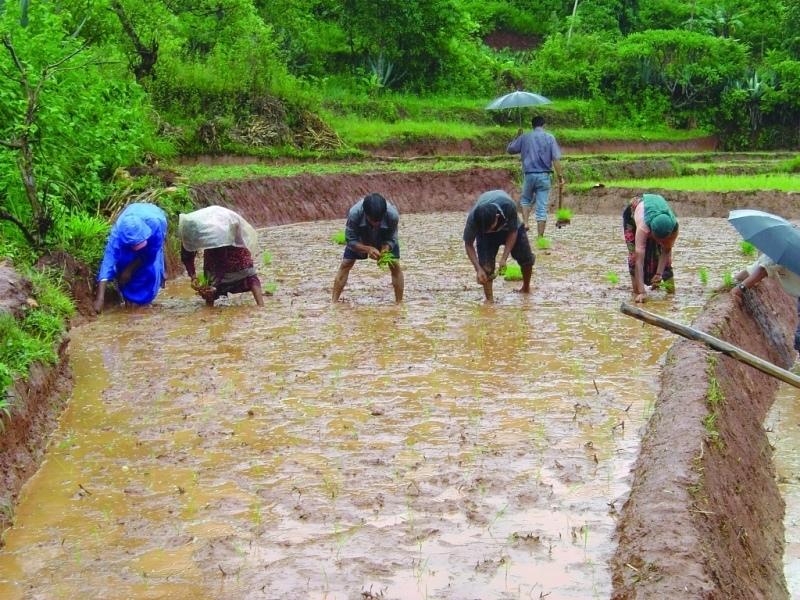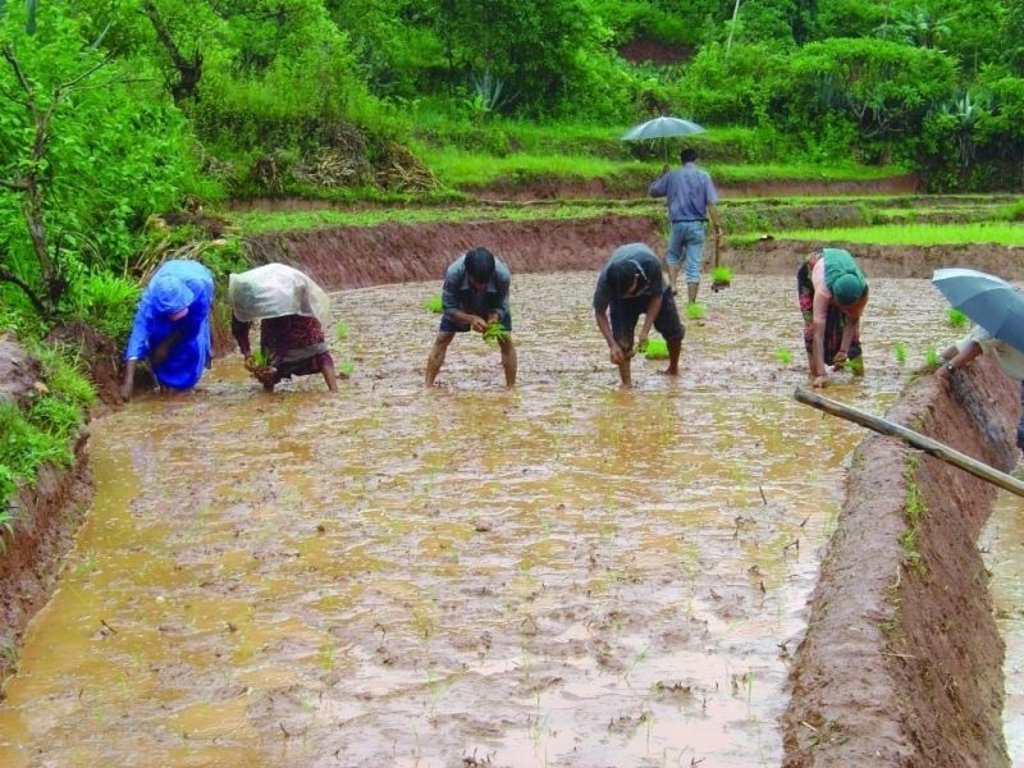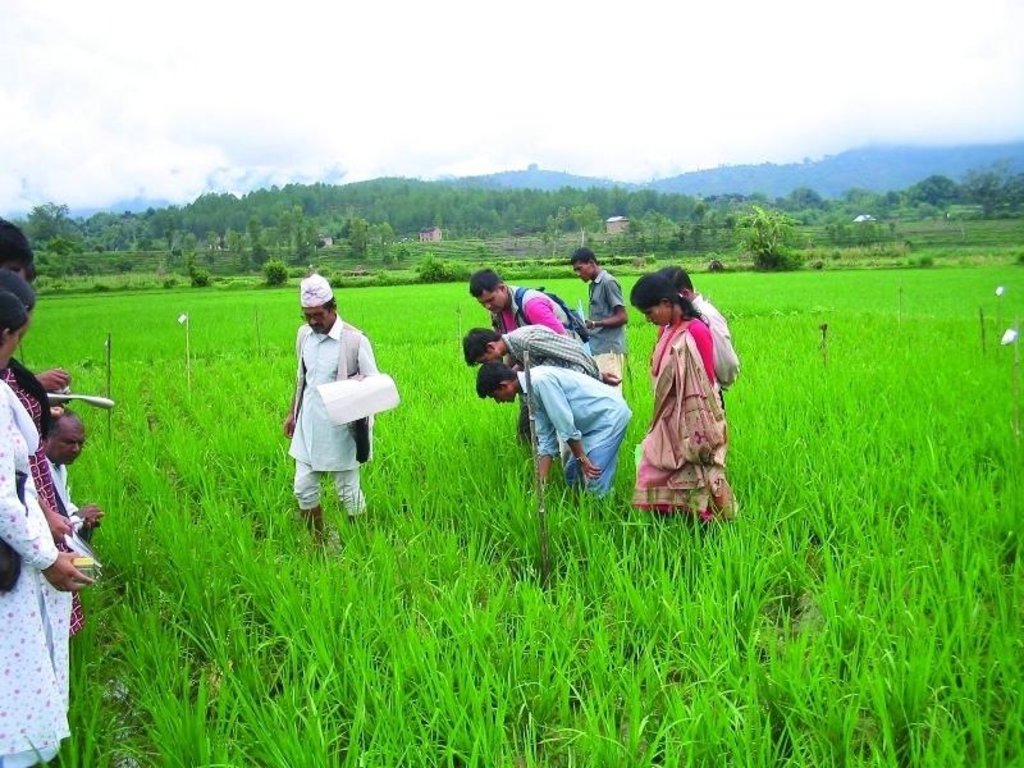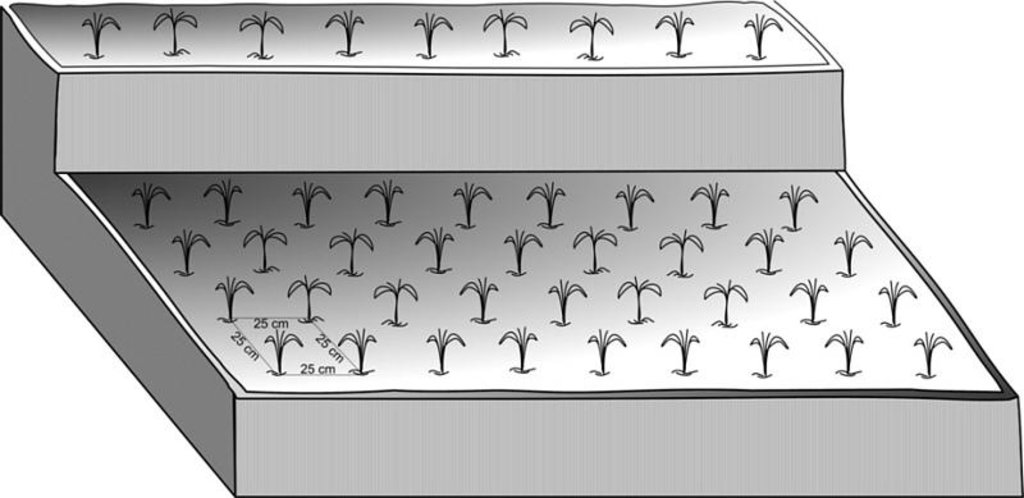System of Rice Intensification [Nepal]
- Criação:
- Atualização:
- Compilador/a: Madhav Dhakal
- Editor: –
- Revisores: David Streiff, Alexandra Gavilano
Dhan uttapadan bridi garne tarika - Nepali
technologies_1494 - Nepal
Veja as seções
Expandir tudo Recolher tudo1. Informação geral
1.2 Detalhes do contato das pessoas capacitadas e instituições envolvidas na avaliação e documentação da tecnologia
Especialista em GST:
Especialista em GST:
Especialista em GST:
Nome da(s) instituição(ões) que facilitou(ram) a documentação/ avaliação da Tecnologia (se relevante)
ICIMOD International Centre for Integrated Mountain Development (ICIMOD) - Nepal1.3 Condições em relação ao uso da informação documentada através de WOCAT
O compilador e a(s) pessoa(s) capacitada(s) aceitam as condições relativas ao uso de dados documentados através do WOCAT:
Sim
1.5 Referência ao(s) questionário(s) sobre abordagens GST (documentado(s) usando WOCAT)
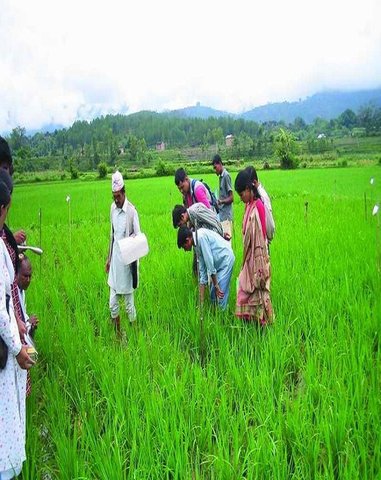
Evaluation of the System of Rice Intensification through … [Nepal]
Conducting participatory action research with farmers and district level line agencies for demonstrating, disseminating and scaling up SRI
- Compilador/a: Madhav Dhakal
2. Descrição da tecnologia de GST
2.1 Descrição curta da tecnologia
Definição da tecnologia:
A method for increasing the productivity of rice by changing the management of plants, soil, water, and nutrients.
2.2 Descrição detalhada da tecnologia
Descrição:
The System of Rice Intensification (SRI) was developed in Madagascar by Henri de Laulanie, in the 1980s. He worked with Malagasy farmers and colleagues to improve the possibilities of rice production. The practice contributes to both healthier soil and healthier plants, supported by greater root growth and the nurturing of soil microbial abundance and diversity. It is based on a number of well-founded agro-ecological principles. SRI concepts and practices have also been successfully adapted to upland rice.
SRI involves transplanting very young rice seedlings (usually 8-12 days old with just two small leaves) carefully and quickly so as to cause minimum disturbance to the roots. The seedlings are planted individually, in contrast to the traditional method where clumps of 3-4 are planted together, minimising root competition between the seedlings. The seedlings are kept widely spaced to allow better root and canopy growth, in a square grid pattern at a spacing of at least 25 x 25 cm. Planting can be done even wider at 30 x 30 or 40 x 40 cm and even up to 50 x 50 cm in the best quality soils.
The soil is kept moist but well drained and aerated to support increased biological activity. A small quantity of water is applied during the vegetative growth period following which a thin layer of water is maintained on the fields only during the flowering and grain-filling stages. Better quality compost, such as well decomposed farmyard manure, can be applied to achieve additional yield increases. Since weed growth will be more abundant and will be a problem in fields that are not kept flooded (and because of the wider spacing), weeding needs to be done at least once or twice in the first 10-12 days and a total of three or four times altogether before the canopy closes.
SRI does not require additional inputs like new seeds, chemical fertiliser or pesticides, but it does require the skilful management of the factors in production and, at least initially, 25-50% more labour inputs, particularly for the transplanting and weeding. As farmers become more skilled and confident in SRI, the amount of labour needed decreases and can eventually become the same or even less than with conventional methods.
SRI is being tried out by farmers in many areas of Nepal’s middle mountains including in the Jhikhu Khola watershed. This area has an altitude of 800-2200 masl, and receives about 1200 mm annual rainfall, about 70-80% in the monsoon months (June to September).
2.3 Fotos da tecnologia
2.5 País/região/locais onde a tecnologia foi aplicada e que estão cobertos nesta avaliação
País:
Nepal
Especificação adicional de localização:
Kavre palanchowk/Jhikhu Khola watershed
Especifique a difusão da tecnologia:
- Uniformemente difundida numa área
Se a área precisa não for conhecida, indicar a área aproximada coberta:
- < 0,1 km2 (10 ha)
Comentários:
This was the first year of on farm research cum demonstration on the farmers field after the trial in the research station. Six farmers tested SRI in 2003. It was tested in Panchkhal, Hokse, Bhimsensthan, Baluwa, and Patalekhet VDCs.
Map
×2.6 Data da implementação
Caso o ano exato seja desconhecido, indique a data aproximada:
- menos de 10 anos atrás (recentemente)
2.7 Introdução da tecnologia
Especifique como a tecnologia foi introduzida:
- através de projetos/intervenções externas
Comentários (tipos de projeto, etc.):
Madagascar
3. Classificação da tecnologia de GST
3.1 Principal/principais finalidade(s) da tecnologia
- Melhora a produção
3.2 Tipo(s) atualizado(s) de uso da terra onde a tecnologia foi aplicada

Terra de cultivo
- Cultura anual
Cultivo anual - Especificar culturas:
- cereais - milho
- legumes - outros
- rice, wheat
Número de estações de cultivo por ano:
- 3
Especifique:
Longest growing period in days: 150; Longest growing period from month to month: Jun - Oct; Second longest growing period in days: 120; Second longest growing period from month to month: Nov - Feb
Comentários:
major cash crop: Vegetables
major food crop: Rice
other: Maize, wheat
Major land use problems (compiler’s opinion): Limited production due to soil fertility decline, increased amount of agrochemical inputs and lack of sufficient irrigation water and irrigation infrastructures.
Major land use problems (land users’ perception): Decreased production, lack of irrigation facilities and increased amount of chemical fertilizers.
3.4 Abastecimento de água
Abastecimento de água para a terra na qual a tecnologia é aplicada:
- Misto de precipitação natural-irrigado
3.5 Grupo de GST ao qual pertence a tecnologia
- Medidas pós-colheita
3.6 Medidas de GST contendo a tecnologia

Medidas de gestão
- M2: Mudança de gestão/nível de intensidade
3.7 Principais tipos de degradação da terra abordados pela tecnologia

Deteriorização química do solo
- Cn: declínio de fertilidade e teor reduzido de matéria orgânica (não causado pela erosão)
Comentários:
Main causes of degradation: urbanisation and infrastructure development (poor irrigation infrastructures), other natural causes (avalanches, volcanic eruptions, mud flows, highly susceptible natural resources, extreme topography, etc.) specify (uneven distribution of precipitation throughout the year), land tenure (population growth, separating famility members from a household.), labour availability (out migration for a off-farm employment)
Secondary causes of degradation: other human induced causes (specify) (Weak institutional collaboration), poverty / wealth (lack of government subsidy on agricultural sector), education, access to knowledge and support services (lack of sufficient discussion with concerned technicians and experienced farmers.)
3.8 Redução, prevenção ou recuperação da degradação do solo
Especifique o objetivo da tecnologia em relação a degradação da terra:
- Reduzir a degradação do solo
4. Especificações técnicas, implementação de atividades, entradas e custos
4.1 Desenho técnico da tecnologia
Especificações técnicas (relacionada ao desenho técnico):
In the SRI method young seedlings (8-12 days old) are planted singly at a wide spacing of 25 x 25 cm or more
Technical knowledge required for field staff / advisors: moderate
Technical knowledge required for land users: low
Main technical functions: improved plant management, improved soil management, improved water management
Secondary technical functions: increase in organic matter, increase in soil fertility
Change of land use practices / intensity level: Planting method, irrigation method and soil fertility management is carriedout differently compare to traditional method.
Autor:
Madhav Dhakal , A. K. Thaku
4.2 Informação geral em relação ao cálculo de entradas e custos
Especifique como custos e entradas foram calculados:
- por área de tecnologia
Indique o tamanho e a unidade de área:
1 ha
Especifique a moeda utilizada para os cálculos de custo:
- USD
Indique a média salarial da mão-de-obra contratada por dia:
2.10
4.4 Custos e entradas necessárias para a implantação
Comentários:
Duration of establishment phase: 0 month(s)
4.5 Atividades recorrentes/manutenção
| Atividade | Periodicidade/frequência | |
|---|---|---|
| 1. | Application of fertilizer | |
| 2. | Application of pesticides ( if required) | |
| 3. | Transplantation | monsoon, 8 to 12 days after seed sowing / |
| 4. | Irrigation of the mainfield ( to keep fields alternately dry and moist) | vegetative period / weekly after transplantation; |
| 5. | Weeding | vegetative period / 3-4 times; first within 10 day |
| 6. | Harvesting | October/November / |
| 7. | Nursery bed preparation, seed treatment and sowing | Beginning of monsoon / |
| 8. | Main field preparation ( ploughing and leveling) | Beginning of monsoon / |
4.6 Custos e entradas necessárias pata a manutenção/atividades recorrentes (por ano)
| Especifique a entrada | Unidade | Quantidade | Custos por unidade | Custos totais por entrada | % dos custos arcados pelos usuários da terra | |
|---|---|---|---|---|---|---|
| Mão-de-obra | Maintaining field | Persons/day | 353,0 | 2,1 | 741,3 | 100,0 |
| Equipamento | Machin use | ha | 1,0 | 136,0 | 136,0 | 100,0 |
| Material vegetal | Seeds | ha | 1,0 | 4,0 | 4,0 | 100,0 |
| Fertilizantes e biocidas | Fertilizer | ha | 1,0 | 94,0 | 94,0 | 100,0 |
| Fertilizantes e biocidas | Biocoides | ha | 1,0 | 56,0 | 56,0 | 100,0 |
| Custos totais para a manutenção da tecnologia | 1031,3 | |||||
| Custos totais de manutenção da Tecnologia em USD | 1031,3 | |||||
Comentários:
labour: person -day, cost of agrochemicals
All costs were estimated in 2006.
4.7 Fatores mais importantes que afetam os custos
Descreva os fatores mais determinantes que afetam os custos:
Due to increased off-farm employment trend , there is lack of manpower for field operation, which increases the labour cost .
5. Ambiente natural e humano
5.1 Clima
Precipitação pluviométrica anual
- <250 mm
- 251-500 mm
- 501-750 mm
- 751-1.000 mm
- 1.001-1.500 mm
- 1.501-2.000 mm
- 2.001-3.000 mm
- 3.001-4.000 mm
- > 4.000 mm
Especifique a média pluviométrica anual em mm (se conhecida):
1200,00
Zona agroclimática
- úmido
Thermal climate class: subtropics
5.2 Topografia
Declividade média:
- Plano (0-2%)
- Suave ondulado (3-5%)
- Ondulado (6-10%)
- Moderadamente ondulado (11-15%)
- Forte ondulado (16-30%)
- Montanhoso (31-60%)
- Escarpado (>60%)
Formas de relevo:
- Planalto/planície
- Cumes
- Encosta de serra
- Encosta de morro
- Sopés
- Fundos de vale
Zona de altitude:
- 0-100 m s.n.m.
- 101-500 m s.n.m.
- 501-1.000 m s.n.m.
- 1.001-1.500 m s.n.m.
- 1.501-2.000 m s.n.m.
- 2.001-2.500 m s.n.m.
- 2.501-3.000 m s.n.m.
- 3.001-4.000 m s.n.m.
- > 4.000 m s.n.m.
Comentários e outras especificações sobre a topografia:
Landforms: Also hill slopes
5.3 Solos
Profundidade do solo em média:
- Muito raso (0-20 cm)
- Raso (21-50 cm)
- Moderadamente profundo (51-80 cm)
- Profundo (81-120 cm)
- Muito profundo (>120 cm)
Textura do solo (solo superficial):
- Médio (limoso, siltoso)
- Fino/pesado (argila)
Matéria orgânica do solo superficial:
- Médio (1-3%)
- Baixo (<1%)
Caso disponível anexe a descrição completa do solo ou especifique as informações disponíveis, p. ex. tipo de solo, PH/acidez do solo, nitrogênio, capacidade de troca catiônica, salinidade, etc.
Soil depth on average: Variable
Soil fertility is very low - low
Soil drainage / infiltration is medium - poor
Soil water storage capacity is medium
5.4 Disponibilidade e qualidade de água
Qualidade da água (não tratada):
Água potável precária (tratamento necessário)
Comentários e outras especificações sobre a qualidade e a quantidade da água:
Availability of surface water: Maximum during rainy season (June to september), starts decresing from October reaching minimum in April/May
Water quality (untreated): Poor more in rainy season (June- September), less in April/May, but otherwise good drinking water
5.6 Características dos usuários da terra que utilizam a tecnologia
Orientação de mercado do sistema de produção:
- Subsistência (autoabastecimento)
Rendimento não agrícola:
- 10-50% de toda renda
Nível relativo de riqueza:
- Pobre
- Média
Indivíduos ou grupos:
- Indivíduo/unidade familiar
Nível de mecanização:
- Trabalho manual
- Tração animal
Gênero:
- Mulheres
- Homens
Indique outras características relevantes dos usuários da terra:
Land users applying the Technology are mainly common / average land users
Population density: 200-500 persons/km2
Annual population growth: 2% - 3%
15% of the land users are rich and own 35% of the land.
35% of the land users are average wealthy and own 40% of the land.
50% of the land users are poor and own 25% of the land.
Off-farm income specification: In most farm households, off-farm income plays at least a minor and increasingly a major role. Occasional opportunities for off-farm income present themselves in the form of daily
Level of mechanization: Manual labour for planting, irrigation, harvesting, animals are used for field preparation and machines as well but in the valley bottom.
5.7 Área média de terrenos utilizados pelos usuários de terrenos que aplicam a Tecnologia
- < 0,5 ha
- 0,5-1 ha
- 1-2 ha
- 2-5 ha
- 5-15 ha
- 15-50 ha
- 50-100 ha
- 100-500 ha
- 500-1.000 ha
- 1.000-10.000 ha
- > 10.000 ha
É considerado pequena, média ou grande escala (referente ao contexto local)?
- Pequena escala
5.8 Propriedade de terra, direitos de uso da terra e de uso da água
Propriedade da terra:
- Indivíduo, intitulado
Direitos do uso da terra:
- Indivíduo
Direitos do uso da água:
- Comunitário (organizado)
6. Impactos e declarações finais
6.1 Impactos no local mostrados pela tecnologia
Impactos socioeconômicos
Produção
Produção agrícola
Comentários/especificar:
10 - 57 percent grain yield increased
Produção de forragens
Comentários/especificar:
3 - 40 percent above ground bio -mass increased
Qualidade da forragem
Comentários/especificar:
3 - 40 percent above ground bio -mass increased
Renda e custos
Rendimento agrícola
Comentários/especificar:
due to increased grain and biomass; seed , fertilizer, and labour saving,
Carga de trabalho
Comentários/especificar:
only the first weeding is labour intensive
Impactos socioculturais
Instituições comunitárias
Comentários/especificar:
planning, discussing in a group and implementing the method systematically
Conhecimento de GST/ degradação da terra
Comentários/especificar:
use of organic fertilizer, reduced chemical fertilizer application, different method of irrigation management adopted
livelihood and human well-being
Comentários/especificar:
due to increased yield
Impactos ecológicos
Outros impactos ecológicos
soil fertility
Comentários/especificar:
use of organic fertilizer, reduced chemical fertilizer application
6.2 Impactos externos mostrados pela tecnologia
Disponibilidade de água
Comentários/especificar:
more irrigation water available for downstream, because SRI uses less water than traditional method
6.3 Exposição e sensibilidade da tecnologia às mudanças climáticas graduais e extremos/desastres relacionados ao clima (conforme o ponto de vista dos usuários da terra)
Mudança climática gradual
Mudança climática gradual
| Estação do ano | aumento ou diminuição | Como a tecnologia lida com isso? | |
|---|---|---|---|
| Temperatura anual | aumento | bem |
Extremos (desastres) relacionados ao clima
Desastres meteorológicos
| Como a tecnologia lida com isso? | |
|---|---|
| Temporal local | não bem |
| Tempestade de vento local | não bem |
Desastres climatológicos
| Como a tecnologia lida com isso? | |
|---|---|
| Seca | não bem |
Desastres hidrológicos
| Como a tecnologia lida com isso? | |
|---|---|
| Inundação geral (rio) | não bem |
Outras consequências relacionadas ao clima
Outras consequências relacionadas ao clima
| Como a tecnologia lida com isso? | |
|---|---|
| Período de crescimento reduzido | não bem |
6.4 Análise do custo-benefício
Como os benefícios se comparam aos custos de implantação (do ponto de vista dos usuários da terra)?
Retornos a curto prazo:
neutro/balanceado
Retornos a longo prazo:
positivo
Como os benefícios se comparam aos custos recorrentes/de manutenção(do ponto de vista dos usuários da terra)?
Retornos a curto prazo:
positivo
Retornos a longo prazo:
positivo
Comentários:
If rice fields need to be established, the short-term establishment costs and the benefits realised are about the same. However, most farmers already had rice fields and therefore the benefits are more than the costs.
6.5 Adoção da tecnologia
- > 50%
Se disponível, determine a quantidade (número de unidades familiares e/ou área abordada):
35 households in an area of 10 ha
De todos aqueles que adotaram a Tecnologia, quantos o fizeram espontaneamente, ou seja, sem receber nenhum incentivo/ pagamento material?
- 91-100%
Comentários:
100% of land user families have adopted the Technology without any external material support
35 land user families have adopted the Technology without any external material support
Comments on spontaneous adoption: survey results
There is a moderate trend towards spontaneous adoption of the Technology
Comments on adoption trend: Farmers are adopting the SRI method carefully and slowly by at first only putting small areas under SRI and then
slowly increasing the area planted.
SRI is an innovation rather than a technology. It is gaining popularity all over the world. Increased yields of 50-100% have been reported in most places where it has been tried. The practice is gaining popularity in Nepal especially in the eastern Terai plains.
6.7 Pontos fortes/vantagens/oportunidades da tecnologia
| Pontos fortes/vantagens/oportunidades na visão do usuário da terra |
|---|
|
Compared to the traditional method, SRI consumed 50 to 75% less water, 75% less seed, 50% less labour for transplanting, 50-60% less labour for irrigation, and less pesticide; the cost of fertiliser and harvesting remained the same, thus the overall cost of production is the same or a little less How can they be sustained / enhanced? More experience sharing would help expand the area under SRI |
|
40-50% more grain production and 20-25% increase in above ground biomass production compared to traditional method How can they be sustained / enhanced? Experience sharing would help expand the area under SRI |
| Lodging is observed less due to longer root in case of SRI |
| Conflict over water during irrigation time reduced |
| Pontos fortes/vantagens/oportunidades na visão do compilador ou de outra pessoa capacitada |
|---|
|
SRI method saved time required for irrigation, reduced disease and pest attacks, and reduced lodging problem. How can they be sustained / enhanced? More research is required to calculate exact amount of water saving. |
|
SRI method improved soil environment and reduced rates of riser collapse How can they be sustained / enhanced? Impact of long-term soil nutrient balance has yet to be studied |
| SRI method saved seed |
| Cost of production was same or little less compared to traditional method. |
|
Compared to traditional method, grain yield nearly doubled in SRI without additional external inputs. How can they be sustained / enhanced? Emphasis should be given on understanding the process involved in SRI , not just obtain information about the net benefits. |
6.8 Pontos fracos, desvantagens/riscos da tecnologia e formas de superá-los
| Pontos fracos/desvantagens/riscos na visão do usuário da terra | Como eles podem ser superados? |
|---|---|
| Compared to traditional method, cost for weeding is 50-60%.higher and the first weeding is difficult. | Overall cost remains the same. A simple low cost mechanical weeder can lower the cost of weeding in the long run.. |
| Compared to traditional method, transplanting young seedling , maintaining the spacing and handling young seedling is difficult. | Confidence building is essential, this can be achieved by practicing it 2-3 times. |
| Transporting delicate seedlings from the nursery beds to the field and transplanting it requires proper skill. | More practice is required. |
| Pontos fracos/vantagens/riscos na visão do compilador ou de outra pessoa capacitada | Como eles podem ser superados? |
|---|---|
| Water control is most difficult part of this method; to maintain alternate dry and moist field conditions, water needs to be available at 5 - 6 day intervals. | There needs to be good irrigation infrastructure or a perennial source of water to irrigate rice fi elds regularly |
| Transplanting 8-12 day old seedlings, especially under rainfed conditions, is quite diffi cult. Seedlings become old and unfi t for transplanting when there is no rain during the transplanting time |
Establish two to three nursery beds at intervals of one week |
| This method is only suitable for smallholder farmers, in most countries it is not adopted on a large scale. | Involvement of national departments and local institutions and wider sharing of its proven benefi ts is vital to upscale the innovation. |
7. Referências e links
7.1 Métodos/fontes de informação
7.2 Referências às publicações disponíveis
Título, autor, ano, ISBN:
IRRI International Rice Research Institute, www.irri.org.
Título, autor, ano, ISBN:
ICIMOD (2007) ‘Good Practices in Watershed Management, Lessons Learned in the Mid Hills of Nepal. Kathmandu: ICIMOD
Disponível de onde? Custos?
ICIMOD
Título, autor, ano, ISBN:
Uphoff, N. (2004) ‘System of Rice Intensification Responds to 21st Century Needs’. In Rice Today, 3 (3):42
Links e módulos
Expandir tudo Recolher tudoLinks

Evaluation of the System of Rice Intensification through … [Nepal]
Conducting participatory action research with farmers and district level line agencies for demonstrating, disseminating and scaling up SRI
- Compilador/a: Madhav Dhakal
Módulos
Não há módulos


